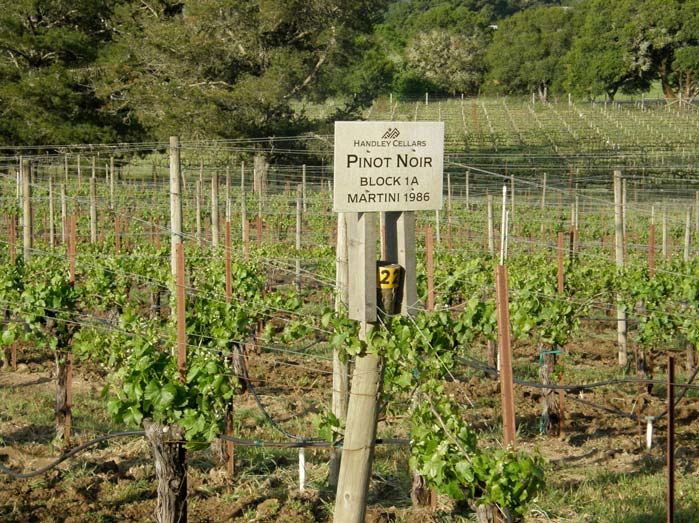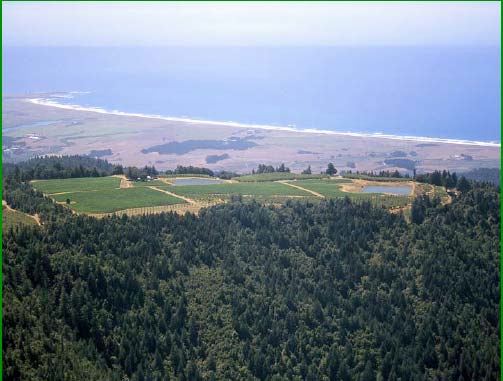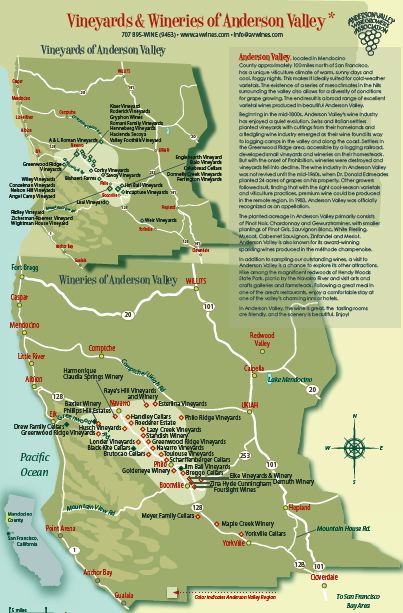Anderson Noir Valley
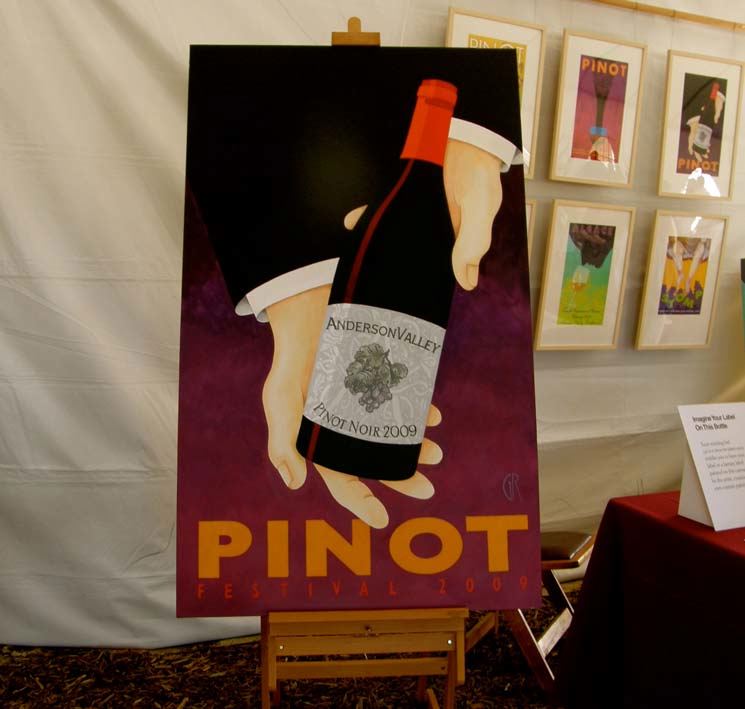
Anderson Valley will never rival its southerly neighbor, the Russian River Valley, for notoriety. Retirees and
urban refugees with money seeking the wine lifestyle won’t fine the creature comforts here. There is no
restaurant scene, spa or high-end lodging. The local inhabitants discourage tourism, calling intruders “wine and-
cheese gentry.” Their worst fear is that this bucolic valley might become a destination wine region. The
locals’ disdain for city people is reflected in the unique language of the Anderson Valley known as boontling,
which refers to visitors as “brightlighters.” Despite this indigenous aversion to outsiders, the pinotphile
cognoscenti have descended on the Anderson Valley, reveling in the magnificent Pinot Noirs that are
threatening to make this slow lane region a wine lover’s paradise. Pinotphiles are a determined group, addicts
if you will, looking for that next fix of Pinot Noir and rarely deterred by a challenge. They will travel anywhere to
find what Adam Lee of Siduri Wines calls “true-believer” wineries that produce Pinot Noir because “it is the true
enological love of their lives.”
Anderson Valley is one of eleven grape-growing appellations in Mendocino County, California, but is the most
uniquely suited to growing that insolent grape, Pinot Noir. Plantings of Pinot Noir in Mendocino County (2,204
acres) are overshadowed by Chardonnay and Cabernet Sauvignon and rank fifth among the other major Pinot
Noir growing regions of California (Sonoma,10,192 acres, Monterey, 7,123 acres, Santa Barbara, 4,140 acres
and Napa, 2,756 acres). The average price per ton for Mendocino Pinot Noir ranks fourth in the state at $2,486, trailing Sonoma ($3,168), Santa Barbara ($3,106), and Napa ($2,588), and exceeding Monterey
($1,842). Exceptional Anderson Valley Pinot Noir vineyards can command up to $6,000 per ton.
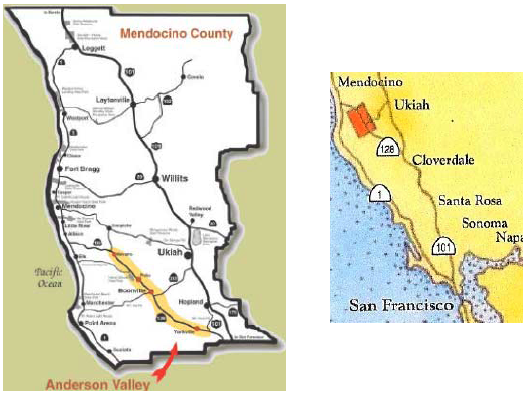
Anderson Valley is located between mile marker 9 and 50 on Highway 128, 120 miles north of San Francisco.
It is a relatively isolated area mostly less than a mile across with 1,000+ foot mountains on both sides. The
valley floor is about 18 miles long and opens on its northern end to the Pacific coast by way of the Navarro
River Canyon. At this most northerly portion of the Anderson Valley, the Pacific Ocean is but a 15 mile twisting
drive away. The resulting marine influence allows morning fog to roll into the valley and gentle breezes to enter
in the afternoon. A gradient is created, with the northern end, referred to by locals as “down-valley,” or the
“deep end,” receiving more rain and fog and thus being cooler, and the southern more inland portion, or “upper valley,”
being typically 8-10 degrees warmer. The valley’s vineyards and wineries are clustered along the
fringes and rolling hills adjacent Highway 128, which bisects the valley in a south to north direction, with a
majority of the vineyards located down-valley. Along Highway 128, the vineyards begin at the town of
Boonville, continue north through Philo, and end in the tiniest hamlet of the three, Navarro, population 67.

Most visitors access the Anderson Valley by way of Highway 128 as it departs westward from Highway 101 at
Cloverdale, 80 miles north of San Francisco (Confusingly, Highway 128 east is approached first heading north
and takes you to Guerneville). Once on Highway 128 west, the traveler enters a pastoral land of great beauty,
the pulse slowing with each mile traversed, assuming you don’t meet with any timber trucks barreling south on the narrow two-lane highway. The world of roadside McDonalds and gas stops is left behind, replaced by a
countryside laced with lichen-covered oaks, towering redwoods, ramshackle old barns, and calmly grazing
sheep and cows. The smell of skunks and hay fills the air. In 30 minutes, Yorkville appears, the town center of
the Yorkville Highlands AVA. There are 22 vineyards here planted to 21 different wine grape varietals primarily
at higher elevations between 1,000 and 2,200 feet. Cabernet Sauvignon is most suitable for this warm region
where the vineyards, all family run, average 18 acres each. There are a few microclimates suitable for Pinot
Noir in Yorkville Highlands, notably the Weir Vineyard at mile marker 43.3 farmed by owners Bill and Suki Weir.
About 50 acres of Pinot Noir total are planted in the Yorkville Highlands. After leaving Yorkville and another 15
minutes of driving, the township of Boonville appears, the so-called “center of activity” in the valley. About
3,000 people are scattered throughout the Anderson Valley, a fourth of them calling Boonville home.
Boonville is known as “Boont” in the unique local language of Anderson Valley known as boontling. In the
1800s, this code-like dialect become the spoken word for many of the valley residents. The exact origins are
unclear, but many attribute the derivation to the mothers and children who worked in the hop fields that were
prevalent in the valley at the time. The isolation of the valley and the distrust of visitors fostered the language.
Terms included: “Boont Region” (Anderson Valley) “baul seep” (lovers of wine), “baul hornin” (good drinking),
“Frati” (wine - Mr. Frati was a local vineyard owner), “Frati shams” (wine grapes), “backdated chuck” (someone
who is behind the times) and "Boontners" (speakers of Boontling). Many of the words were derived from other
languages including Scottish, Irish, Spanish and the dialect of the Pomo Indians who were the original Native
American settlers of the Anderson Valley. Today, fragments of boontling persist as slang terms.
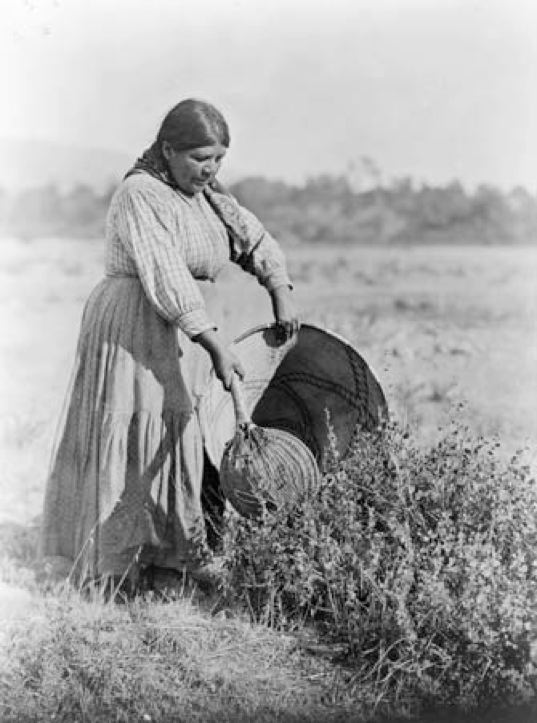
Among the first white settlers in the Anderson Valley were the Anderson family who arrived in 1851. Walter
Anderson planted the first apple trees in the valley and this became an agricultural staple. Hop fields became
ubiquitous and a thriving sheep and timber industry developed. The 1960s brought an influx of hippies who
were drawn to the beauty and isolation of the valley. They fostered an illicit marijuana enterprise which to this
day remains the biggest grossing agricultural product in the valley, exceeding wine grape growing. During the
1970s and 1980s, urban escapees, so-called “back-to-the-landers,” bought ranches and replaced apple
orchards with vineyards. This movement continues at a slow pace to this day. The latest newcomers to the
valley are Mexican laborers valued for their work in the vineyards. Olives are the newest crop and several olive
oil producers including well-regarded Stella Cadente have appeared.
The history of winegrowing in Mendocino County is linked most closely with Parducci (the oldest modern
winery in the region dating to 1931) and Fetzer (dating to the late 1960s), both of whom flooded the market
through the years with wines of reliable value from the warmer areas of Mendocino County outside the bounds
of the Anderson Valley. The history of viticulture in the Anderson Valley goes back to the Italian immigrants who
arrived from San Francisco and successfully raised grapes above the valley along the Greenwood Ridge in
what is know the Mendocino Ridge AVA. The immigrants favored Zinfandel, Muscat, Malvasia and Palomino.
The DuPratt Vineyard, planted in 1916 on Mendocino Ridge is still viable. In the 1940s and 1950s, attempts to
grow grapes in the valley by Asti, Goodhue and Pinoli were largely unsuccessful due to problems with ripeness
and frost. The modern history of winegrowing in the Anderson Valley is linked to four names: Edmeades,
Husch, Lazy Creek and Navarro.
In 1963, Dr. Donald Edmeades, a cardiologist from Pasadena, California, bought the Nunn Ranch, consisting
of 108 acres of grazing and orchard land north of Philo. He planted 24 acres of grapes excluding Pinot Noir in
the late 1960s. The locals were quite skeptical and Edmeades, in good humor, put up a sign on Highway 128
that read, “Edmeades’ Folly.” In truth Edmeades had carefully researched the potential for grape growing in
the Anderson Valley and had been visiting the region on vacations since the 1950s. The University of
California Davis viticulturists had completed a survey of the climate of the valley at the time and classified it
primarily as Region I (up to 2,500 degree days), ideal for cool-climate grapes. Edmeades was successful
growing Chardonnay and Gewürztraminer, and supplied Parducci and Seghesio for nearly ten years. In 1972,
the Edmeades winery and label was launched but both Donald and his wife passed away from cancer just after
his winery was built. His son Deron took over and crafted the first vintage. Edmeades, which was acquired by
Kendall-Jackson in 1988, achieved notoriety with Zinfandel but was never a major player in the Pinot Noir
game in the valley.
The first Pinot Noir planted in the Anderson Valley was at Husch Vineyards in 1968. Founder Wilton (Tony)
Husch had been exposed to Pinot Noir by John Parducci and after acquiring the 60-acre Nunn Ranch halfway
between Philo and Navarro, selected a 3-acre parcel of the Husch estate known as the Knoll block. According
to John Haeger (North American Pinot Noir, p 309), the original plantings were taken from Wente’s Arroyo Seco
vineyard. In 1971 the first crop was harvested, and the back room of the Nunn Ranch house, built in 1920,
became the first modern winery in the valley. Long time vineyard manager, Al White, arrived in 1973. As Al
recounts his first harvest at Husch in 1974, clearly vineyard management was archaic at the time.
The vines were planted with 8’ by 12’ spacing with overhead irrigation. Trellising was minimal and no leaf
pulling was done. Rain at harvest was a problem and with it came mold for which there was little suitable
treatment. The grapes were picked to apple boxes at a very casual pace over several days by a hippie crew.
The Knoll block is still producing Pinot Noir, but was inter planted with Dijon 667 clone in 2001 and transformed
by modern viticultural practices. Tony Husch sold the property in 1979 and there have been a string of
winemakers and owners since then.
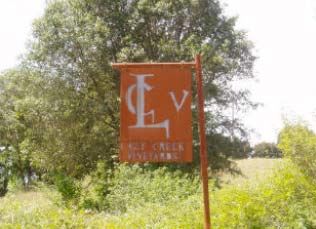
The third noteworthy modern winegrowing pioneer in the Anderson
Valley was a restaurateur from San Francisco, Johann Kobler and
his wife Theresia. They bought the 20-acre Lazy Creek Vineyards
in 1969 from the Pinoli family who started their farm in Philo in the
early 1900s. According to the Anderson Valley Historical Society,
Joe Pinoli had the first bonded winery in the valley in 1911 and
planted the first vineyards on the valley floor. The Pinolis had
more success with fruit orchards than vineyards. Kobler was able
to revitalize the vineyards and built a small winery in 1973. He
had success with both Pinot Noir and Gewürztraminer. Josh and
Mary Beth Chandler acquired Lazy Creek Vineyards in 1999 and
carried on the tradition admirably until 2008 when they sold the
estate to Ferrari-Carano. Ferrari-Carano continues to manage
Lazy Creek Vineyards as a separate winery and label.
Ted Bennett was a successful businessperson when he and his wife, Deborah Cahn, left San Francisco in
1973 and bought a 900-acre sheep ranch along Highway 128 between Philo and Navarro. They were Alsatian
grape aficionados and initially only planted white varieties beginning with their first plantings in 1974. Pinot Noir
came later and today they have 31 acres of estate Pinot Noir and source additional Pinot Noir from other
Anderson Valley vineyards. Their marketing prowess was largely responsible for Anderson Valley’s recognition
among wine enthusiasts. They built a welcoming tasting room and regularly sent out an informative newsletter
that led to considerable consumer-direct sales. The second generation, Aaron and Sarah Cahn Bennett, are
actively involved in the winery today. The long time gray-bearded winemaker is Ted Klein, who can easily be
confused in appearance with owner Ted Bennett. Today, their lineup of quality wines is impressive and includes
Gewürztraminer, Riesling, Sauvignon Blanc, Pinot Gris, Muscat, Syrah, Zinfandel and Pinot Noir (three
bottlings including Anderson Valley, Méthode a l’Ancienne and Deep End Blend). Navarro Vineyards & Winery
has broken ground recently on a second winery located in Boonville and are adding new plantings nearby.
Although the Edmeades, Husch, Lazy Creek and Navarro wineries laid the groundwork for success, Anderson
Valley’s validation as a premium grape-growing area was firmly established by two sparkling wine producers,
Roederer Estate in the early 1980s and subsequently Schraffenberger. Still, the public’s perception of
Anderson Valley wines has lagged primarily due to the small number of wineries, the sale of large amounts of
grapes to wineries located in Napa and Sonoma with more visible profiles, and the anti-tourism and
anti development attitude that is prevalent among the residents of the valley. The paucity of lodging and
creature comforts have prevented the Anderson Valley from becoming a wine destination and many visitors to
the valley simply pass through on their way to the Mendocino Coast, stopping only at a few visible winery
tasting rooms on Highway 128.
Some have compared the Anderson Valley to Oregon’s Willamette Valley which is similarly largely rural and not
overwrought by tourism. Both climates fall into the coolest Region I, with Oregon being cooler at 1,924 Celsius
degree-days compared to Anderson Valley at 1,900 to 2,300 Celsius degree-days (Burgundy is at 1,982
Celsius degree-days). Rainfall is almost identical in the two regions, averaging about 40 inches annually. In
addition, Anderson Valley wines bear more resemblance to those from the Willamette Valley than to other
California appellations, and as a result, the Anderson Valley has been dubbed “Baja Oregon.” The structural
elements, that is the tannins and acidity of Pinot Noir from the Anderson and Willamette Valley, are closely
aligned with Burgundy. What distinguishes Anderson Valley from Oregon is the heavily marine-influenced
climate. The Willamette Valley is largely protected from the Pacific coast by its Coastal Range of mountains,
but the proximity to the Pacific Ocean at Anderson Valley’s deep end leads to the frequent intrusion of
afternoon ocean breezes and evening fog, resulting in a temperature moderating effect most prominent in the
summer. As the sun goes down, warm days give way rapidly to very cool evenings resulting in marked diurnal
variation (a midday temperature of 82 degrees might give way to a nighttime temperature of 45 degrees). This
allows the grapes to accumulate acidity and retain it. The downside is that nighttime cold snaps can create
frost damage to vines. The 2008 vintage year was marked by the worst series of frosts in April since the early
1970s. Flower damage on primary buds from last year are shown below right compared to a healthy vine from
Handley Cellars this May.
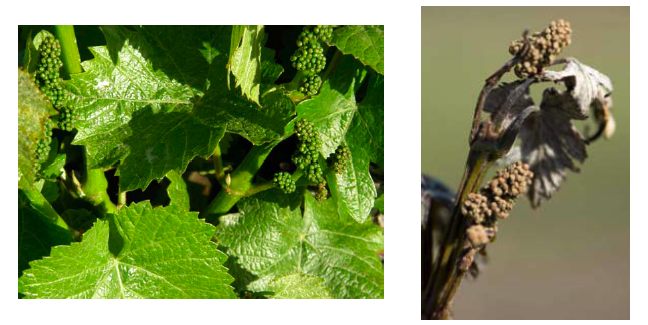
While both Oregon and the Anderson Valley began plantings of Pinot Noir about the same time in the mid
1960s, Oregon’s quicker accent to success can be largely attributable to the clones that were planted. While
Oregon was committed initially to Pommard and Wädenswil clones, both of which turned out to be quite
appropriate for the Willamette Valley climate, Oregon had the advantage of earlier and widespread plantings of
the cool-climate Dijon clones. Anderson Valley was primarily planted to California heritage and sparkling wine
clones initially. The Dijon clones, which are earlier ripening and often more suitable to the climate in Anderson
Valley, came later. The Anderson Valley has had to catch up, but today as newer plantings of Dijon clones are
reaching significant maturity, the Pinot Noirs are fulfilling the promise of “baul hornin’”
Besides Pinot Noir, the Anderson Valley is perfectly suited for Alsatian varieties such as Pinot Gris, Riesling
and Gewürztraminer. Each year the Anderson Valley hosts an International Alsace Varietals Festival in
February. Chardonnay can also shine in the Anderson Valley and is an important component of the region’s
sparklers.
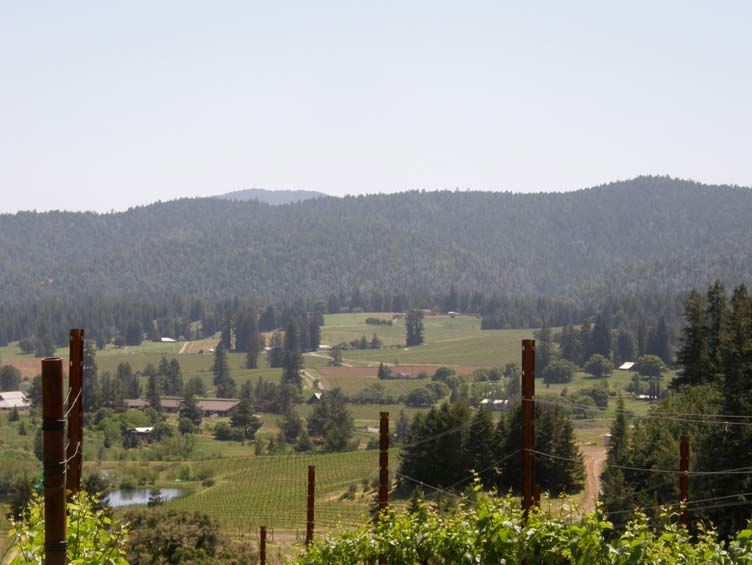
Mendocino Ridge
Mendocino Ridge is a newer American Viticultural Area winning approval in 1997, yet has
some of the oldest producing vineyards in Mendocino County. The first plantings, primarily
Zinfandel, were established by Italian immigrants and date to the late 1800s. Today, Zinfandel
is still the pride of this AVA, but the area holds promise as California's newest “hot spot” for
Pinot Noir.
The Mendocino Ridge AVA is a non contiguous trio of ridges that is defined by vineyards at
least 1,200 feet or more in elevation and within 10 miles of the Pacific Ocean. It is California's
first and only non contiguous AVA. Because of the hilly terrain of the AVA some lower elevations
are not included, fostering the name, “Islands in the Sky™.” This catchy name is trademarked by
Dan Dooling, owner of Mariah Vineyards, and one of the winegrowers along with Steve Alden
of Perli Vineyard to successfully achieve appellation status for the region. The ridge is a
twisting 12 mile uphill westward drive along Philo Greenwood Road from the Anderson Valley floor.
Refer to map on page 2.
The climate is different from the Anderson Valley below. Perched above the fog and frost
threat, the vineyards bask in the early morning sun, and early afternoon breezes cool down the
fruit, never allowing the temperatures to rise as high as the valley below. The diurnal variation
during the growing season is significantly less than the valley below (20 degrees versus 40
degrees). There is enough rainfall and ground water to dry farm vineyards. According to
winemaker Van Williamson of Edmeades, “Mendocino Ridge grapes produce wines intense in
fruit, high in acidity and structured for aging in the cellar.”
The first winery in the AVA was Greenwood Ridge Vineyards in 1980 (their tasting room is in
the Anderson Valley below). The original Greenwood Ridge Vineyard was planted by Tony
Husch in 1972 and was acquired in 1973 by Greenwood Ridge owner Allen Green. Listen to Allen Green speak about Mendocino Ridge: [audio.60 |“Allen Green at AV Technical Symposium”]]
Other Pinot Noir plantings include Manchester Ridge Vineyard (19 acres of Pinot Noir and 11 acres
of Chardonnay), Perli Vineyard (6.5 acres of Pinot Noir) and Sky High Vineyard. Other
wineries producing Pinot Noir in the Mendocino Ridge appellation include Baxter Winery,
Drew, and Phillips Hill Estates. Wineries sourcing fruit from the Mendocino Ridge AVA include
Arista (Perli Vineyard), Ferrari-Carano (owners of Sky High Vineyard) and Auteur, B. Kosugi, J.
Jacamon, Marguerite Ryan Cellars, Tandem (all Manchester Ridge Vineyard).
I have had spectacular Pinot Noirs from Manchester Ridge Vineyard. Greg La Follette, former
winemaker at Flowers, commented on the first Pinot Noir harvested from Manchester Ridge in
2005 and said, “....this vineyard is bound to be another Flowers Camp Meeting Ridge - even
better.” The vineyard is pictured below from the Manchester Ridge Vineyard website at
www.manchesterridge.com.
Currently there are 28 wineries and more than 60 vineyards in the Anderson Valley. Some of the vineyard
names have become household words to pinotphiles: Cerise, Demuth, Donnelly Creek, Ferrington, Klindt,
Morning Dew Ranch, Savoy, Toulouse and Wiley. For a full listing of Anderson Valley wineries and vineyards
and an extensive map (see below) consult the Anderson Valley Winegrowers Association website at
www.avwines.com.
Over 30 major California Pinot Noir producers outside the Anderson Valley appellation access grapes from
Anderson Valley: Anthill Farms, Arista Winery, Adrian Fog, Barnett, Benovia, Brogan Cellars, Cakebread
Cellars, Copain Wines, Couloir Wines, Chronicle Wines, Dain Wines, Drew, Fulcrum Wines, Hartford Family
Wines, Harrington, Ici/La-Bas, La Crema Winery, Littorai, MacPhail Family Wines, Madrigal Vineyards,
Papapietro-Perry, Radio-Coteau, Roessler Cellars, Saintsbury, Skewis, Tudor, Twomey, Waits-Mast Family
Cellars, Whitcraft, Williams-Selyem and Woodenhead.
Most of the vineyards in the Anderson Valley are less than 10 acres, with three large growers, Roederer Estate,
Goldeneye and Navarro controlling the most total vineyard acreage. Pinot Noir acreage has dramatically
increased since 1997, and now accounts for more than 50 percent of Anderson Valley’s vineyard plantings.









